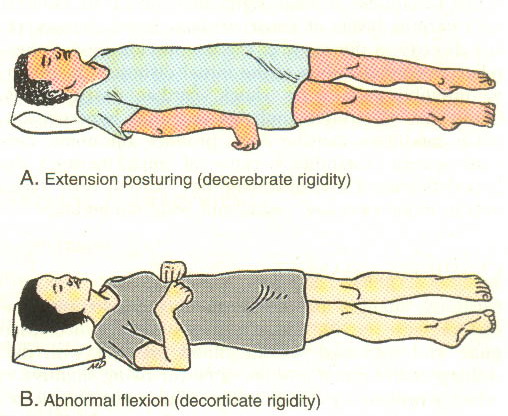Hypertonicity vs spasticity: Difference between revisions
Scott Buxton (talk | contribs) No edit summary |
No edit summary |
||
| Line 6: | Line 6: | ||
== Hypertonicity or spastic dystonia == | == Hypertonicity or spastic dystonia == | ||
Hypertonicity or spastic dystonia is a | Hypertonicity or spastic dystonia is a continuous increase in the muscle tension without regard to the movement being performed. It is dependent upon afferent information from feedback following movements of stretch. Decorticate and decerbrate rigidity are a form of spastic dystonia. Spastic dystonia is considered to be a form of sustained efferent muscular hyperactivity, dependent on continuous supraspinal drive to the alpha motor neuron. <ref>Clinical evaluation and management of spasticity, Jeffery et. al.2002</ref> | ||
<br> | <br> | ||
[[Image:Decorticate.jpg]]<br> | [[Image:Decorticate.jpg|centre]]<br> | ||
= <br> = | = <br> = | ||
| Line 16: | Line 16: | ||
== Spasticity == | == Spasticity == | ||
Spasticity is a velocity-dependent increase in muscle tone in response to passive movement. Pyramidal tract injury doesn't give rise to spasticity. Rather, the main symptoms are weakness and loss of dexterity which is greater in distal than in the proximal muscles. The pyramidal tract is the system which balances muscle tone. | |||
=== | === Neural Component of Spasticity === | ||
#Dorsoreticulospinal tract (DRT) | #Dorsoreticulospinal tract (DRT) - has inhibitory effect on MRT and VST | ||
#medial reticulospinal tract (MRT) | #medial reticulospinal tract (MRT) and [[Vestibulospinal Tract|Vestibulospinal tract]] (VST): - have facilitatory effect on the extensor tone. | ||
All three systems are thought to inhibit flexor reflex afferents responsible for flexor spasm. | |||
== References == | == References == | ||
| Line 33: | Line 30: | ||
<references /> | <references /> | ||
[[Category:Cerebral_Palsy]] | [[Category:Cerebral_Palsy]] | ||
Revision as of 20:48, 29 August 2016
Original Editors - Saeed Dokhnan
Top Contributors - Saeed Dokhnan, Laura Ritchie, Lucinda hampton, Admin, Kate Sampson, Kim Jackson, Aya Alhindi, Evan Thomas and Scott Buxton
Hypertonicity or spastic dystonia[edit | edit source]
Hypertonicity or spastic dystonia is a continuous increase in the muscle tension without regard to the movement being performed. It is dependent upon afferent information from feedback following movements of stretch. Decorticate and decerbrate rigidity are a form of spastic dystonia. Spastic dystonia is considered to be a form of sustained efferent muscular hyperactivity, dependent on continuous supraspinal drive to the alpha motor neuron. [1]
[edit | edit source]
Spasticity[edit | edit source]
Spasticity is a velocity-dependent increase in muscle tone in response to passive movement. Pyramidal tract injury doesn't give rise to spasticity. Rather, the main symptoms are weakness and loss of dexterity which is greater in distal than in the proximal muscles. The pyramidal tract is the system which balances muscle tone.
Neural Component of Spasticity[edit | edit source]
- Dorsoreticulospinal tract (DRT) - has inhibitory effect on MRT and VST
- medial reticulospinal tract (MRT) and Vestibulospinal tract (VST): - have facilitatory effect on the extensor tone.
All three systems are thought to inhibit flexor reflex afferents responsible for flexor spasm.
References[edit | edit source]
- ↑ Clinical evaluation and management of spasticity, Jeffery et. al.2002







